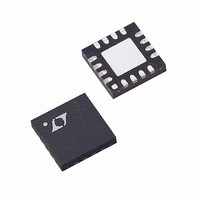LTC6404CUD-1#PBF Linear Technology, LTC6404CUD-1#PBF Datasheet - Page 21

LTC6404CUD-1#PBF
Manufacturer Part Number
LTC6404CUD-1#PBF
Description
IC AMP/DRIVER DIFF 16-QFN
Manufacturer
Linear Technology
Type
ADC Driverr
Datasheet
1.LTC6404CUD-1PBF.pdf
(28 pages)
Specifications of LTC6404CUD-1#PBF
Applications
Data Acquisition
Mounting Type
Surface Mount
Package / Case
16-WQFN Exposed Pad
Current - Supply
27.8mA
Operating Temperature
0°C ~ 70°C
Output Type
Differential, Rail-to-Rail
Number Of Circuits
1
Current - Output / Channel
85mA
Amplifier Type
Differential
Voltage - Supply, Single/dual (±)
2.7 V ~ 5.5 V, ±1.35 V ~ 2.75 V
-3db Bandwidth
600MHz
Slew Rate
450 V/µs
Gain Bandwidth Product
500MHz
Current - Input Bias
23µA
Voltage - Input Offset
500µV
No. Of Amplifiers
1
Input Offset Voltage
2mV
Gain Db Max
1dB
Bandwidth
500MHz
Supply Voltage Range
2.7V To 5.25V
Supply Current
27.8mA
Amplifier Case Style
QFN
Rohs Compliant
Yes
Number Of Channels
1
Number Of Elements
1
Power Supply Requirement
Single
Common Mode Rejection Ratio
60dB
Voltage Gain Db
90dB
Unity Gain Bandwidth Product (typ)
500MHz
Input Resistance
1MOhm
Single Supply Voltage (typ)
3/5V
Dual Supply Voltage (typ)
Not RequiredV
Power Supply Rejection Ratio
60dB
Rail/rail I/o Type
Rail to Rail Output
Single Supply Voltage (min)
2.7V
Single Supply Voltage (max)
5.25V
Dual Supply Voltage (min)
Not RequiredV
Dual Supply Voltage (max)
Not RequiredV
Operating Temp Range
0C to 70C
Operating Temperature Classification
Commercial
Mounting
Surface Mount
Pin Count
16
Package Type
QFN EP
Lead Free Status / RoHS Status
Lead free / RoHS Compliant
Available stocks
Company
Part Number
Manufacturer
Quantity
Price
APPLICATIONS INFORMATION
V
V
mon mode voltage):
and V
voltages:
When the feedback ratios mismatch (Δβ), common mode
to differential conversion occurs.
Setting the differential input to zero (V
gree of common mode to differential conversion is given
by the equation:
In general, the degree of feedback pair mismatch is a
source of common mode to differential conversion of both
signals and noise. Using 1% resistors or better will mitigate
most problems, and will provide about 34dB worst-case of
common mode rejection. Using 0.1% resistors will provide
about 54dB of common mode rejection. A low impedance
ground plane should be used as a reference for both the
input signal source, and the V
V
quality 0.1μF ceramic capacitor to this ground plane, will
further prevent common mode signals from being con-
verted to differential.
There may be concern on how feedback ratio mismatch
affects distortion. Distortion caused by feedback ratio mis-
match using 1% resistors or better is negligible. However,
in single supply level shifting applications where there is
a voltage difference between the input common mode
voltage and the output common mode voltage, resistor
mismatch can make the apparent voltage offset of the
amplifi er appear higher than specifi ed.
The apparent input referred offset induced by feedback
ratio mismatch is derived from the following equation:
INCM
INP
OCM
V
V
V
V
, and V
INDIFF
OSDIFF(APPARENT)
INCM
OUTDIFF
to this ground or bypassing the V
INDIFF
is defi ned as the average of the two input voltages
=
= V
INM
2
1
≈
=
is defi ned as the difference of the input
•
INP
(
(also called the source-referred input com-
V
(
V
OUT
V
INCM
INP
– V
+
INM
+
–
–
≈ (V
V
V
V
INM
OUT
OCM
ICM
)
–
)
– V
•
OCM
β
Δ
OCM
AVG
β
⏐
pin. A direct short of
) • Δβ
V
INDIFF
I
N N DIFF
OCM
= 0), the de-
= 0
with a high
Using the LTC6404-1 in a single supply application on a
single 5V supply with 1% resistors, and the input common
mode grounded, with the V
the worst-case DC offset can induce 25mV of apparent
offset voltage. With 0.1% resistors, the worst case appar-
ent offset reduces to 2.5mV.
Input Impedance and Loading Effects
The input impedance looking into the V
of Figure 1 depends on whether the sources V
V
(V
is simply:
For single ended inputs, because of the signal imbalance
at the input, the input impedance increases over the bal-
anced differential case. The input impedance looking into
either input is:
Input signal sources with non-zero output impedances can
also cause feedback imbalance between the pair of feedback
networks. For the best performance, it is recommended
that the source’s output impedance be compensated for.
If input impedance matching is required by the source,
R1 should be chosen (see Figure 4):
Figure 4. Optimal Compensation for Signal Source Impedance
INM
INP
R
R
R
INP
INP
1
R1 CHOSEN SO THAT R1 || R
R2 CHOSEN TO BALANCE R1 || R
= –V
are fully differential. For balanced input sources
=
V
S
= R
R
=
R
INM
INM
R
INM
INM
INM
R
–
), the input impedance seen at either input
•
S
R
R
= R
=
S
S
R2 = R
⎛
⎜
⎝
R1
I
1
– •
S
2
1
|| R1
INM
⎛
⎝ ⎜
R
R
= R
S
INM
OCM
R
I
S
I
R
+
R
R
F
pin biased at mid-supply,
R
I
I
F
⎞
⎠ ⎟
⎞
⎟
⎠
–
+
LTC6404
INP
R
R
F
F
+
–
or V
6404 F04
INM
INP
21
input
and
6404f













